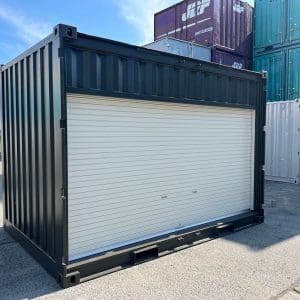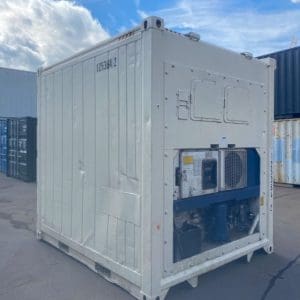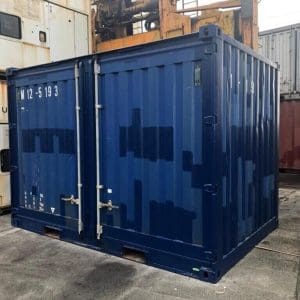Shipping containers are a staple in global trade. They’re used to transport goods across oceans and continents. But have you ever considered their versatility beyond shipping?
This article explores the multifaceted uses of 40ft shipping containers. We’ll delve into their dimensions, weight, and cost. We’ll also discuss how many containers fit on a cargo ship and their square footage. This guide is for you if you are an IT manager or a business owner. It will help you simplify complex information and find a cost-effective storage solution.
Join us as we uncover the potential of 40ft shipping containers.
What is a 40ft Shipping Container?
A 40ft shipping container is a standardized metal box used in transportation. It measures 40 feet long, making it suitable for storing and moving large goods.
These containers are built to resist harsh environmental conditions. They are primarily constructed from corten steel, which offers high durability. Over the years, their use has expanded beyond transportation. Many industries now repurpose them for storage and construction projects.
Their uniform size allows for easy handling and transport across multiple modes, such as ships, trucks, and trains.
Related Products
-
[Used] 12FT container | With wide shutter | Fully painted
$2,380.00 -
10ft High Cube Refrigerated Containers Online
Original price was: $2,500.00.$2,200.00Current price is: $2,200.00. -
12ft container [Used]
Original price was: $2,500.00.$2,000.00Current price is: $2,000.00. -
2 stall restroom trailer for sale
Original price was: $5,700.00.$5,100.00Current price is: $5,100.00.
The Dimensions and Weight of a 40ft Shipping Container
Shipping containers have standard dimensions. A 40ft shipping container is no exception. It typically measures 40 feet in length, 8 feet in width, and 8.5 feet in height.
These dimensions provide ample space for various applications. For professionals, understanding these measurements is crucial. It helps in planning transport and storage efficiently.
Containers’ uniform size ensures compatibility across different transport systems. This standardization simplifies global trade logistics. In addition to dimensions, weight is vital for planning. The container’s weight affects transport options and costs.
Here’s a quick reference:
- Length: 40 feet
- Width: 8 feet
- Height: 8.5 feet
The container’s design maximizes storage and stacking capabilities. This aids in utilizing every inch of available space effectively.
How Much Does a 40ft Shipping Container Weigh?
An empty 40ft shipping container typically weighs around 8,000 pounds. This weight allows for durability and stability while empty. When loaded, its total weight can reach up to 67,200 pounds. This includes the weight of goods plus the container itself.
Understanding this weight range is essential. It ensures safe loading practices and adherence to regulations. Proper weight management helps avoid transport issues. It also prolongs the container’s lifespan by preventing structural stress.
How Wide is a 40ft Shipping Container?
The width of a 40-foot shipping container is standardized at 8 feet, which is consistent across most shipping containers globally. A standard width allows for ease of loading and unloading and helps stack multiple containers effectively.
This uniform width enhances logistical efficiency. It ensures that containers seamlessly fit onto ships, trucks, and trains.
Cost Considerations: How Much Does a 40ft Shipping Container Cost?
The cost of a 40ft shipping container varies. Prices depend on several factors, including condition and location. New containers are typically more expensive. They can range from $3,000 to $5,000. Quality and market demand also influence the cost.
Used containers offer a more budget-friendly option. They are generally cheaper, but prices vary widely. The age and condition of the container play a significant role.
Geographical location impacts pricing as well. Transport costs can increase the overall price if the container needs shipping. It’s essential to consider additional expenses. Modifications or customizations can add to the container’s total cost.
Comparing prices from different suppliers is wise. It ensures you get the best deal suited to your needs and budget.
Capacity and Logistics: How Many 40ft Containers Fit on a Cargo Ship?
The number of 40ft containers a cargo ship can carry varies significantly. It depends on the ship’s design and size. Large cargo ships are engineered to hold thousands of containers. This capacity maximizes efficiency in global trade.
Container ships often measure capacity in TEUs or Twenty-foot Equivalent Units. A 40ft container equals two TEUs. Mega container ships are particularly capable. Some can hold over 18,000 TEUs, translating to thousands of 40ft containers.
Ship logistics ensure proper stacking and stability. These elements are crucial for safety and balanced transport across oceans.
Utilizing Space: How Many Square Feet is a 40ft Shipping Container?
A 40ft shipping container offers approximately 320 square feet of usable space. This is due to its substantial length and standard width. The floor area is comparable to some small apartments. This makes it a versatile option for storage and conversion.
In modular construction, every square foot is valuable. The container’s robust design provides ample floor space. This available area supports various applications. From workshops to pop-up shops, containers offer flexible solutions for different space needs.
The Versatility of 40ft Shipping Containers in Various Industries
40ft shipping containers are transforming industries. Their resilience and flexibility are key. These containers are no longer confined to shipping. Multiple sectors utilize their robust features.
In construction, they serve as the backbone for modular buildings. Quick assembly saves time and cuts costs.
Retailers use them for unique pop-up stores. Their mobility and ample space attract customers In agriculture, they’re transformed into vertical farms. Efficient space utilization benefits growers and the environment.
Key applications of 40ft shipping containers include:
- Modular Construction
- Retail Environments
- Agricultural Solutions
Each application showcases the container’s adaptability. Industries across the board leverage their potential.
Innovative Uses Beyond Shipping and Storage
Beyond traditional roles, containers reinvent spaces. Entrepreneurs embrace their practical design. Tech companies create data centers within containers. Secure, mobile, and scalable, they meet modern demands.
Artists convert them into inspiring studios. Their raw, industrial feel fuels creativity. Emergency housing solutions also utilize these containers. Rapid deployment aids in crises. Community projects benefit, too. Converted containers offer social spaces and recreational facilities.
These innovative uses highlight the container’s versatility. They are not just containers—they’re catalysts for creative solutions.
Buying a 40ft Shipping Container: Tips and Considerations
Purchasing a 40ft shipping container requires thoughtful evaluation. It’s crucial to assess your specific needs. Begin by deciding between new or used containers. New containers offer longevity and minimal wear.
Used containers are cost-effective but should be inspected for damage. Structural integrity is essential for safety. When buying, factor in delivery costs. Transportation can significantly impact your budget.
Consider the container’s intended use as well. This determines the need for modifications or additional features.
Here are key tips for buying:
- Inspect thoroughly for wear and tear
- Consider delivery logistics and costs
- Evaluate the need for modifications
Choosing the right container ensures successful projects. Proper research and planning lead to informed decisions.
Conclusion: The Sustainable and Cost-Effective Choice for Businesses
40ft shipping containers offer remarkable versatility and efficiency. They meet diverse business needs elegantly. Their robust nature ensures durability across various applications.
Additionally, they present cost savings compared to traditional construction methods. This makes them appealing to businesses focused on budget-conscious solutions. Their eco-friendly design reduces the impact on the environment. This is ideal for sustainability-focused companies aiming to make a difference.
Embracing 40ft containers combines practicality with innovation. This trend continues to gain popularity across industries.
Call to Action
Consider the potential of 40ft shipping containers for your business. Invest in a solution that is both sustainable and cost-effective. Explore how these containers can transform your operations. Make a strategic choice that benefits your company long term.





